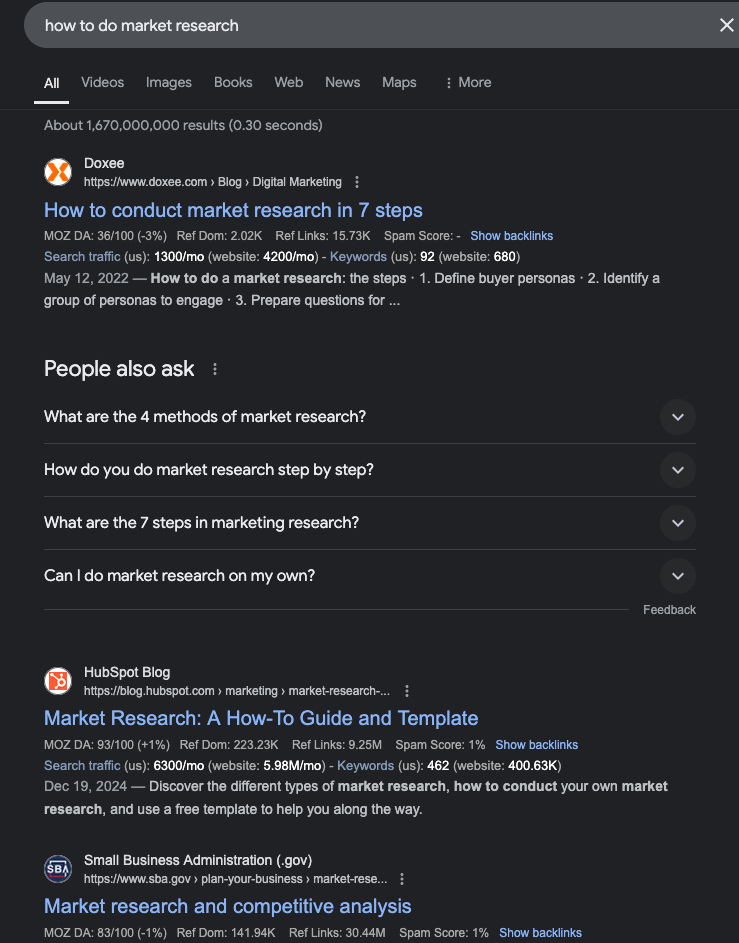
Why Traditional Market Research is Killing Your Startup
I caught myself doing what most first-time founders do: meticulously following every "proper" startup step I read online. Market research templates, competitor analysis frameworks, ideal customer profiles - all the things funded startups spend months perfecting.
Only problem? I was bootstrapped. I had no runway. No team of researchers. No time to waste. I was building beautiful slide decks instead of a business. Playing startup instead of being one. This is the story of how I stopped performing startup theater and found a faster way to validate ideas. No made-up numbers. No fancy frameworks. Just real results in 72 hours.
Because most on the content out there is not for you, once you realise its “AI mass content”

The Traditional Research Trap
Every aspiring founder knows the scene: First, you read all the startup blogs. Then you download those market research templates. Next thing you know, you're knee-deep in spreadsheets trying to estimate your TAM like a VC would.
Here's the trap: VC-backed companies spend months on research because they have to justify millions in funding. They need those perfect slides to convince boards and investors. Their end goal is a pitch deck.
But you? You need customers. Real ones. The kind that pay with real money, not hypothetical market share.
The true cost isn't just time – it's momentum. Every hour spent perfecting research is an hour not spent building. Every day analyzing competitors is a day your idea isn't in front of real customers. Worst of all, all this research gives you a dangerous feeling of progress without any actual validation.
Think about it: Would you rather have a 50-page market research document or 5 customers who've already paid you? Because in the time it takes to make that document, you could've found those customers.
This isn't about skipping research – it's about doing just enough to move forward. Because analysis paralysis isn't just about overthinking. It's about overdoing the wrong things at the wrong time with resources you don't have.
The Anti-Research Principles
This isn't about being reckless - it's about being real. Here are the three principles that actually work when you're bootstrapped:
Speed Over Depth You don't need to understand 100% of your market to start serving 1% of it. While others are diving deep into industry reports, you should be sprinting toward your first sale. Perfect data won't make you profitable - speed to market will.
Real Buyers Over Theoretical Customers One person pulling out their wallet tells you more than 100 people filling out surveys. Stop collecting email addresses from people who "would definitely buy" and start collecting payments from people who actually do. Your ideal customer persona is whoever pays you first.
Action Over Documentation Spreadsheets don't make sales. Stop documenting what you think will happen and start testing what actually does. Every hour spent writing reports is an hour you could spend building, selling, or talking to real customers. Your product changelog will teach you more than any market research document.
The 72-Hour Method
(Inspired by Noah Kagan's Million Dollar Weekend framework)
Day 1: The "Paid Landing Page" Experiment No fancy tools. No complex funnels. Just a simple page with a "Buy Now" button. If you can't explain your idea and get someone excited enough to pull out their credit card in one page, you've got bigger problems than market research. Launch it before dinner. Your goal isn't perfection - it's proof that someone wants this.
Day 2: Put Yourself Out There Get uncomfortable. Message potential customers on LinkedIn,Twitter,Instagram. Join relevant communities. Post about your solution in Facebook groups and discord channels. Share your landing page everywhere your target customers hang out. Don't spam - start conversations. The goal isn't to go viral; it's to get direct, unfiltered feedback from real people who might actually buy.
Day 3: Analyze What Matters Forget vanity metrics. Focus on what actually predicts success:
- Did anyone try to buy?
- What specific objections did people raise?
- Which features did potential customers ask about most?
- What price points did people seem comfortable with?
This is the only research that matters - direct response from people who were interested enough to consider buying. Everything else is just noise.
Real Results vs Research Results
Surveys tell you what people might do. Sales show you what they actually did. A survey response is a promise to buy; a sale is a promise kept. Those first 10 customers teach you more about your market than hundreds of "would you buy this?" responses. A fast "no" saves you months of "maybe." While others are still polishing their research, you've tested three different approaches and found one that works. The market doesn't care about your research – it cares about what you built and whether it solves a real problem. Stop researching. Start building.
Conclusion
The anti-research method isn't about ignoring market validation – it's about stripping away the bureaucracy that kills most startups before they begin. By embracing rapid experimentation, direct customer engagement, and real-world testing over traditional market research.
Stop making moves like a funded startup when you're bootstrapped – your currency is speed, not PowerPoint presentations.